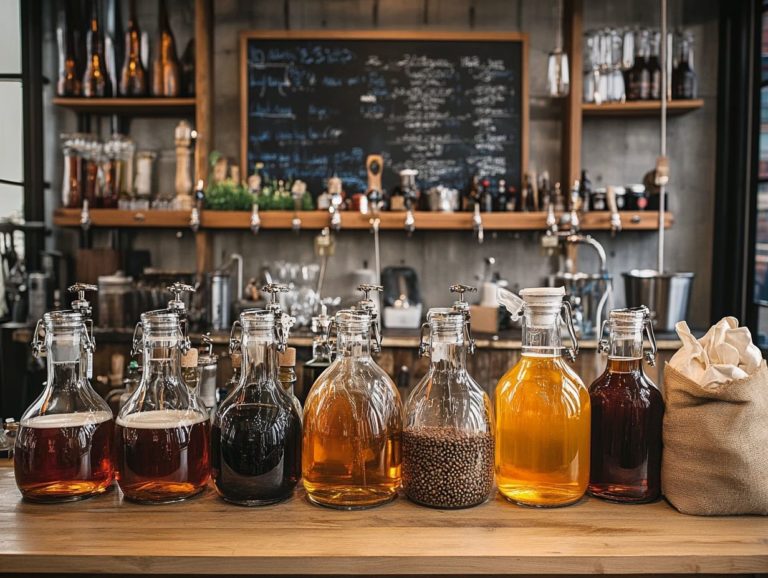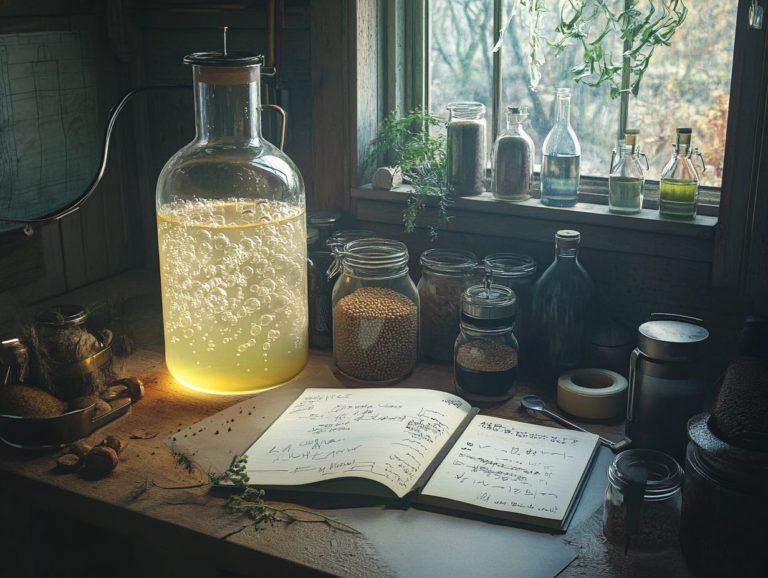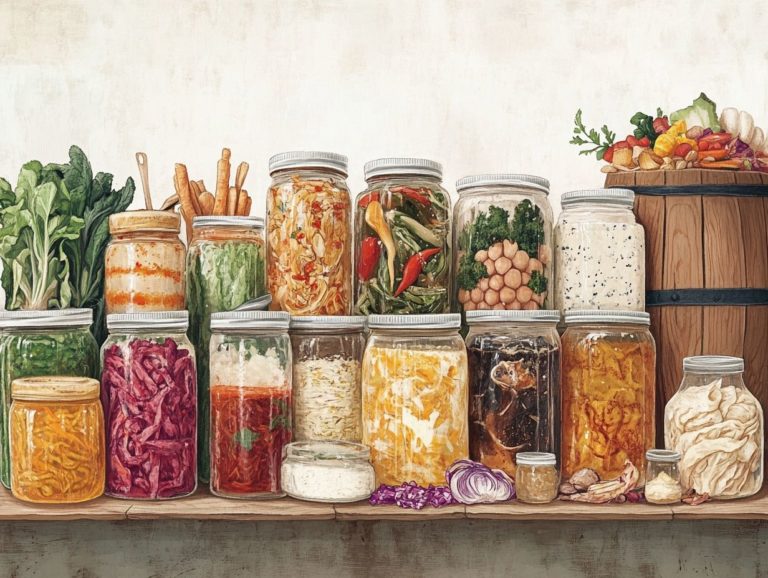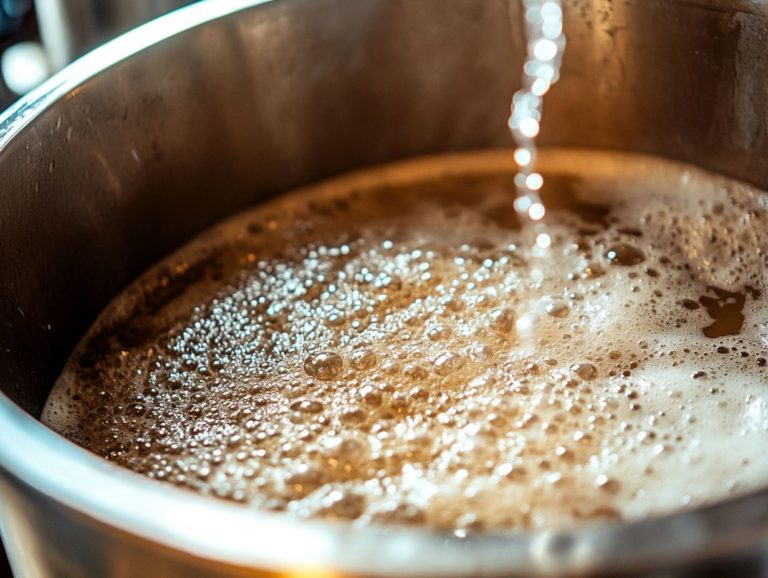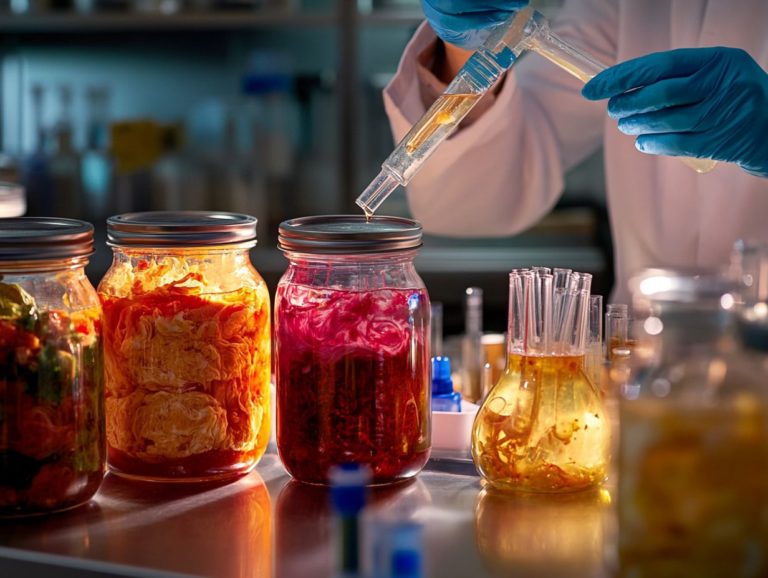Fermentation and the Art of Craft Brewing
Fermentation is a captivating process that transforms simple ingredients into an impressive array of flavors, aromas, and textures. This historical process has fascinated people for centuries.
This article delves into the science of fermentation, uncovering its various types and highlighting its essential role in the creation of craft beer. We will also explore the contributions of pioneers like Louis Pasteur and Emil Hansen to modern brewing science.
By grasping the ingredients and navigating the intricate steps involved in brewing, including yeast pitching and monitoring fermentation parameters, you will enhance your skills in the art of crafting your own brew!
Whether you consider yourself a curious novice or a seasoned enthusiast, you ll discover exciting insights and inspiration throughout this guide.
Contents
- Key Takeaways:
- What is Fermentation?
- How Does Fermentation Work?
- What Are the Different Types of Fermentation?
- What is Craft Brewing? The Art and Science
- How is Craft Brewing Different from Commercial Brewing?
- What Are the Basic Steps of Craft Brewing?
- What Ingredients are Used in Craft Brewing?
- What is the Role of Yeast in Fermentation?
- What Types of Grains and Hops are Used in Craft Brewing?
- What are the Different Styles of Craft Beer?
- What is the Process of Fermentation in Craft Brewing?
- What Are the Benefits of Fermentation in Craft Brewing?
- What are the Health Benefits of Fermented Beer?
- How Can You Start Brewing Your Own Craft Beer at Home?
- What Equipment Do You Need?
- Frequently Asked Questions
- What is fermentation in the context of craft brewing?
- How important is temperature control during fermentation?
- What is the role of yeast in fermentation?
- What is the difference between top-fermenting and bottom-fermenting yeast?
- How long does fermentation typically last in craft brewing?
- Can the flavor of a beer be affected by the fermentation process?
Key Takeaways:
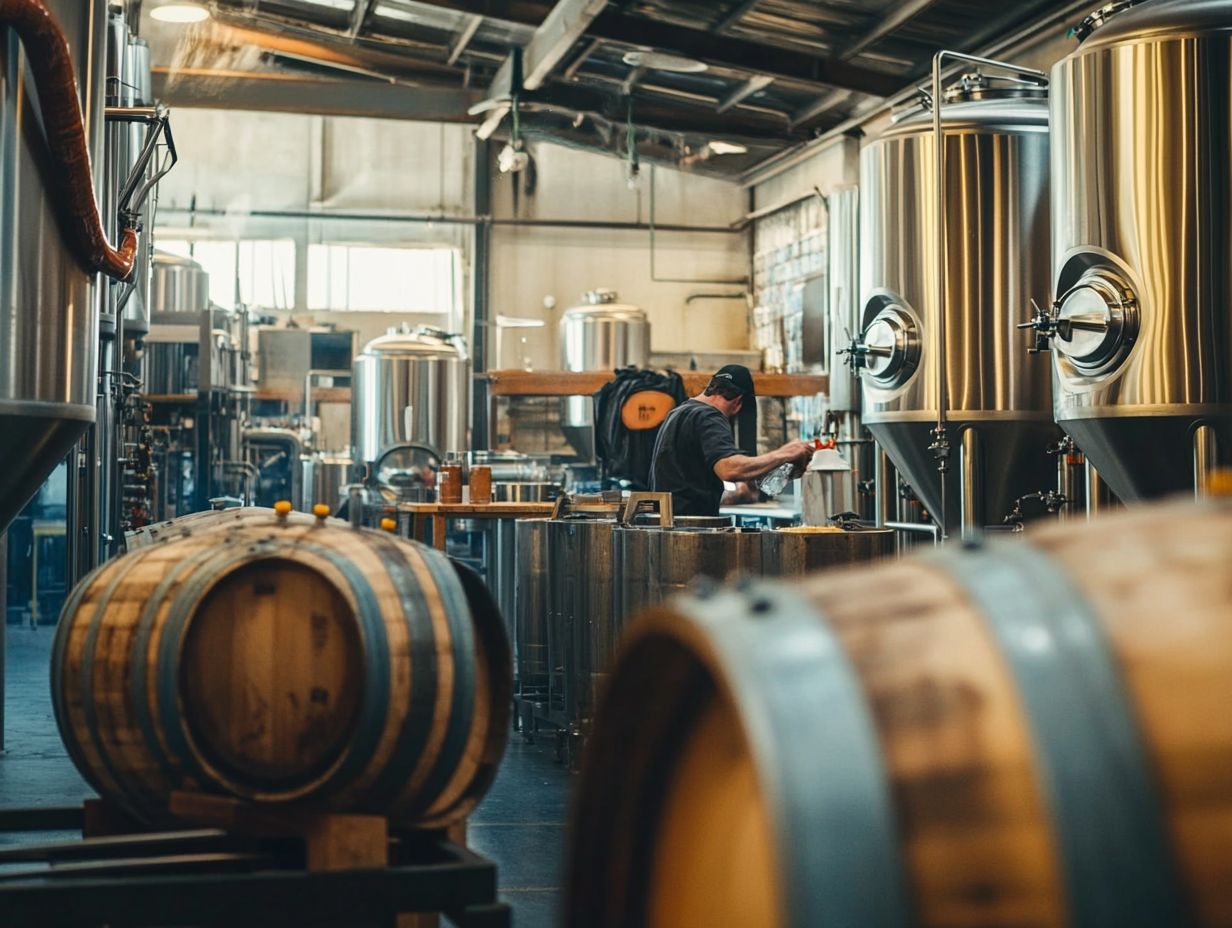
- Fermentation is the process of converting sugars into alcohol and carbon dioxide through the action of yeast.
- Craft brewing involves using traditional and innovative methods to create unique and flavorful beers.
- Yeast, grains, and hops are essential ingredients in craft brewing, each playing a specific role in the fermentation process and contributing to the final taste and aroma of the beer.
What is Fermentation?
Fermentation stands as a pivotal biochemical process that converts sugars into alcohol and carbon dioxide, predominantly facilitated by yeast and a variety of microorganisms. This ancient and scientific practice serves as the cornerstone of brewing, enabling the creation of an impressive range of beer styles, each showcasing distinct flavors and aromas.
The work of Louis Pasteur and later contributions by Carlsberg Laboratories have significantly advanced our understanding of this process.
At its essence, fermentation demands meticulous attention to temperature and oxygen levels. This ensures quality control and delivers optimal outcomes within the realm of brewing science. The nitrogen content and other nutrients during yeast growth also critically influence fermentation characteristics.
How Does Fermentation Work?
Fermentation is a fascinating process that changes sugar into alcohol and carbon dioxide essential elements in the art of brewing beer. The temperature at which fermentation occurs and the levels of oxygen present are pivotal in shaping both the efficiency and the unique characteristics of the fermentation process.
As fermentation unfolds, yeast, particularly Saccharomyces cerevisiae, kicks off glycolysis, breaking down glucose into pyruvate. Pyruvate then undergoes alcoholic fermentation, driven by the work done by enzymes, which are proteins that speed up chemical reactions. This transformation converts pyruvate into acetaldehyde, and then reduces acetaldehyde to ethanol, the very essence of alcoholic beverages.
The pioneering work of Emil Hansen at Carlsberg Laboratories in isolating pure yeast strains has been pivotal in this domain. The variety of fermentable sugars, such as fructose and maltose, directs the yeast’s metabolic pathways, significantly influencing the final flavor profile of your brew.
The production of byproducts like esters and phenols during fermentation introduces unique aromatic characteristics, enriching the overall sensory experience of the beer. Key figures in the history of fermentation, such as Adrian John Brown and Horace Tabberer Brown, made significant contributions to our understanding of these metabolic processes.
Now that you understand fermentation better, why not try brewing your own beer? It s a fun and rewarding experience!
What Are the Different Types of Fermentation?
There are several types of fermentation. The two most noteworthy are primary and secondary fermentation, each playing a unique role in the brewing process.
Primary fermentation kicks off alcohol production by adding yeast to the mixture. Secondary fermentation enhances the flavors and aromas of the final product. Pre-fermentation stages, such as the conditioning phase, are crucial for achieving optimal quality.
Beyond these, other fermentation types hold significant importance in various culinary applications. Take alcoholic fermentation, for instance, where yeast converts sugars into ethanol and carbon dioxide. This process is crucial for brewing beer and fermenting wine.
Then there s lactic acid fermentation, where bacteria transform sugars into lactic acid. This is essential for producing yogurt and sauerkraut, lending a delightful tanginess to these foods. Historical figures like Johann Peter Griess have contributed significantly to our understanding of fermentation in food production.
Acetic acid fermentation takes things a step further by oxidizing ethanol into acetic acid. This process is essential for vinegar production, which finds its way into dressing and marinades.
By grasping these fermentation characteristics, you enhance your understanding of brewing and food production. You can also appreciate the remarkable transformation of simple ingredients into complex flavors and textures. Understanding the microbial and health benefits of different fermentation types can further enrich your knowledge.
What is Craft Brewing? The Art and Science
Craft brewing embodies both the art and science of producing beer in small batches. Here, quality and flavor take center stage alongside traditional brewing techniques. The work of craft brewers, like those in Burton-on-Trent, has been instrumental in shaping the industry.
As a craft brewer, you have the opportunity to experiment with unique yeast strains and innovative methods. This paves the way for an exciting array of beer styles that not only highlight local ingredients but also showcase your creative flair.
You can experiment with different fermentation vessels to enhance the nuances of your brew.
How is Craft Brewing Different from Commercial Brewing?
Craft brewing stands apart from commercial brewing in several key ways, primarily in scale, approach, and an unwavering commitment to quality and distinctive flavors.
Whereas commercial brewing often leans toward mass production and cost efficiency, craft brewing places a premium on high-quality ingredients and innovative brewing techniques. This results in unique aromas and flavors that tantalize the palate.
Craft brewing also emphasizes maintaining a clean environment to ensure the purity of the final product. This meticulous attention to detail extends beyond the brewing process to the very philosophy that defines craft breweries.
Craft breweries cultivate a sense of community and actively engage with their consumers. They often invite patrons to participate in the creative journey of brewing through small-batch releases.
In contrast, larger commercial brewers tend to rely on established recipes and tried-and-true marketing strategies. This leads to a more uniform product line, often involving the use of fermentation vessels that allow for small-batch experimentation.
This fundamental distinction influences the beers crafted and shapes how each type of brewery interacts with its audience. Craft brands excel at fostering loyal followings through personalized experiences and local collaborations, ensuring that each sip tells a story and connects you to the heart of the brewing community.
What Are the Basic Steps of Craft Brewing?
The essential steps of craft brewing involve mashing grains to get fermentable sugars, boiling the wort, pitching yeast, and meticulously controlling the fermentation process. Each of these steps is vital for shaping the quality and character of the final beer, with a strong emphasis on hygiene and temperature management throughout. Adhering to proper brewing techniques ensures optimal outcomes.
Starting with the mashing stage, where enzymes work their magic to break down starches into sugars. The boiling phase is equally significant. This step not only sterilizes but also enhances flavor through the strategic addition of hops every action in the brewing process contributes to the overall masterpiece. It’s important to check the mineral content of the water for the right flavor.
Once your wort reaches the desired gravity, it s time for a rapid cool-down in preparation for yeast pitching, which sets the fermentation in motion. During this stage, yeast will transform sugars into alcohol and carbon dioxide over several days, creating the essence of your brew.
After active fermentation wraps up, the beer enters the conditioning phase. This crucial period allows flavors to mature while unwanted by-products fade away, resulting in a balanced and rich brew that s primed for bottling or kegging. Proper management of fermentation stages, including secondary fermentation, ensures the final product’s quality.
What Ingredients are Used in Craft Brewing?
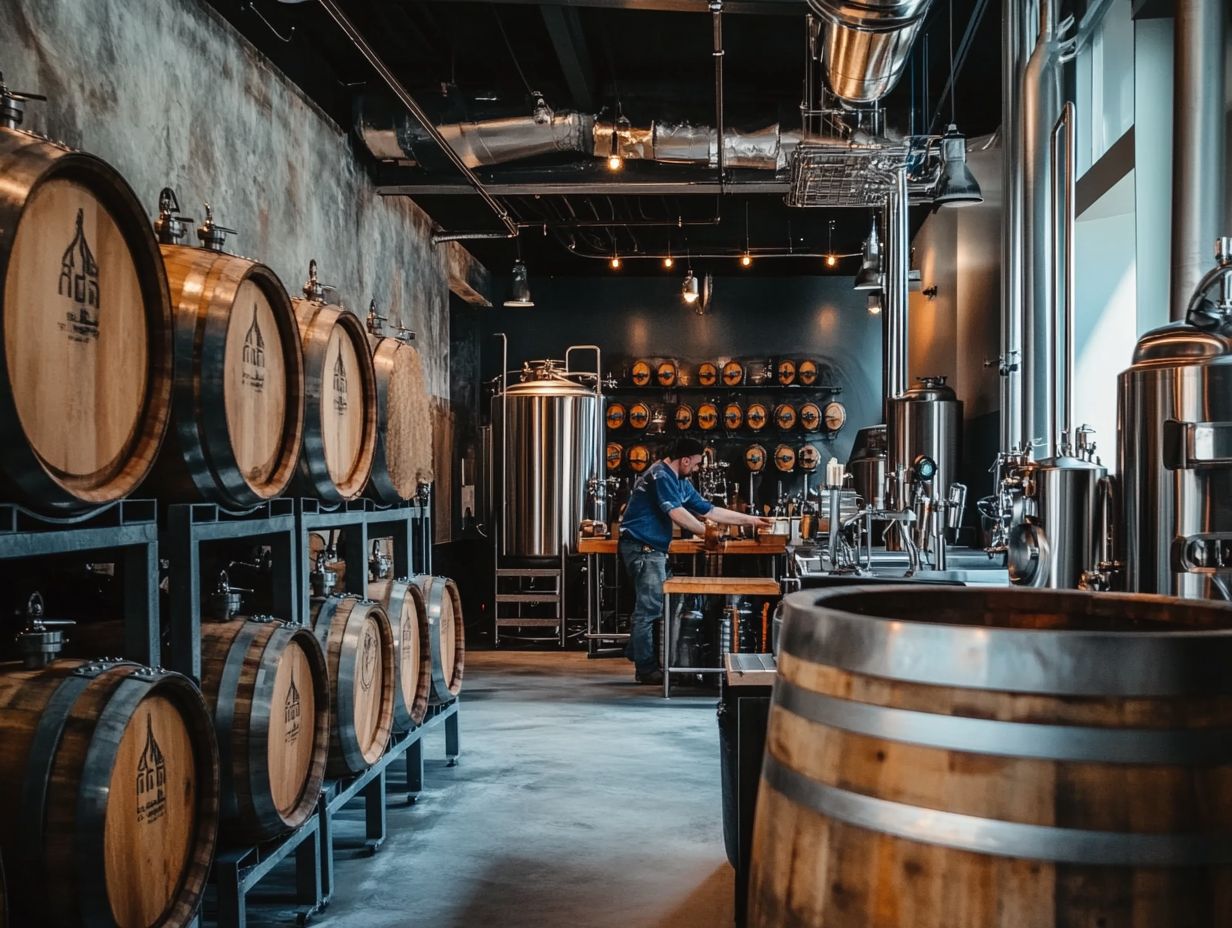
Craft brewing hinges on a selection of carefully chosen ingredients, such as barley, hops, yeast, and water, each contributing to the unique flavors and aromas that define exceptional beer. The nitrogen content and other nutrients also play a critical role in yeast growth and fermentation efficiency.
Every element plays an integral role in the brewing process, influencing the fermentation stages and ultimately enhancing the overall quality of the brew. Craft brewers often use traditional techniques to maintain the purity and integrity of these ingredients.
What is the Role of Yeast in Fermentation?
Yeast is the magic ingredient in brewing! It plays a crucial role in fermentation, as it transforms sugars into alcohol and carbon dioxide during the brewing process. Different yeast strains can impart distinct fermentation characteristics, significantly influencing the flavor and aroma profiles of your final beer. Effective yeast management and proper pitching techniques are essential for the best results.
One of the most commonly used strains, Saccharomyces cerevisiae, thrives at warmer temperatures and produces a remarkable array of esters and phenols, which are compounds that add complex fruity and spicy notes, enhancing the beer s character. This strain is often characteristic of ales. On the other hand, lager yeast, such as Saccharomyces pastorianus, operates best at cooler temperatures, resulting in cleaner, crisper profiles that are perfect for styles like pilsners.
Effective yeast management is essential think of it as the backbone of your brewing success. Temperature control and appropriate pitch rates are critical, as they directly impact fermentation efficiency and the overall quality of your brew. Remember, the yeast you choose not only influences the final product but also serves as a reflection of your artistic vision in the intricate world of brewing. Maintaining a clean environment and monitoring microbial activity are also crucial for achieving the desired outcomes.
What Types of Grains and Hops are Used in Craft Brewing?
Craft brewing invites you to explore a wide array of grains, with barley leading the charge, complemented by diverse hops that elevate the flavors and aromas in beer. The selection of grains and hops plays a pivotal role in shaping the beer’s profile, influencing everything from bitterness to sweetness.
Proper management of fermentation temperature and oxygen levels also significantly impacts these flavors. Beyond barley, you can experiment with other grains like wheat, rye, and oats, each contributing its own unique textures and flavors.
For example, wheat often imparts a crisp, refreshing quality, while rye introduces spicy, earthy notes that enhance the brew’s complexity. Don t forget to include nitrogen-rich grains to aid yeast growth and protein content beneficial for your brew.
On the hops front, varieties like Cascade and Centennial offer delightful floral and citrus aromas, while bolder choices like Chinook deliver piney and resinous characteristics. Mastering the delicate balance of these elements is crucial, enabling you to craft distinct and memorable beers that cater to a spectrum of palates.
What are the Different Styles of Craft Beer?
Craft beer offers an impressive array of styles, each distinguished by its own unique flavors, aromas, and fermentation traits. From the hoppy punch of IPAs to the rich depth of stouts, explore the exciting diversity of craft beer and embark on a delightful tasting journey!
Historically, different beer styles have been influenced by local ingredients and brewing techniques, creating a vast array of flavors and aromas that cater to diverse palates. Burton-on-Trent, for instance, became famous for its pale ales due to the mineral content in its water.
What are the Characteristics of Each Style?
Each style of craft beer boasts distinct characteristics shaped by ingredients, brewing techniques, and fermentation processes. By understanding these traits, you can truly appreciate the nuances found in various beer styles.
Consider IPAs, celebrated for their hoppy bitterness and vibrant aromas that can transport you from citrus groves to pine forests. In contrast, porters invite you into a world of rich, robust flavors, where roasted malt notes evoke the indulgence of chocolate and coffee.
Then there are sours, with their tangy and tart profiles, offering a refreshing contrast, often revealing fruity undertones that dance on your palate. It’s essential to keep in mind the fermentation parameters and how different types of yeast affect beer flavors to achieve the desired flavor and aroma.
By diving into these popular styles, you unlock the artistry and science of brewing, allowing you to forge a deeper connection with each delightful sip you take.
What is the Process of Fermentation in Craft Brewing?
The fermentation process in craft brewing unfolds as a sophisticated dance, where yeast transforms the sugars from the wort into alcohol and carbon dioxide, leading to the exciting creation of beer you can t wait to taste!
The fermentation journey has several key stages, including yeast growth, primary fermentation, secondary fermentation, and conditioning. Each stage is critical to achieving the perfect balance of flavors and aromas in your brew.
How Is Wort Fermented into Beer?
You ferment wort into beer by introducing yeast, which eagerly consumes the sugars. This process results in the production of alcohol and carbonation. Fermentation is essential for developing the unique flavors and aromas that define various beer styles.
Your journey begins with the meticulous selection of yeast strains, as each species imparts distinct characteristics to the final brew. Once you introduce the yeast to the cooled wort, it flourishes in a warm environment, typically between 65 F and 75 F for ales. Here, it starts breaking down sugars through a process called glycolysis, which is how yeast generates energy.
This metabolic reaction generates alcohol and carbon dioxide while also creating a delightful array of flavor compounds, such as esters and phenols. It’s crucial to ensure the fermentation vessel is sanitized to prevent contamination. Airlocks are your best friends here, allowing carbon dioxide to escape while keeping unwanted microorganisms at bay.
After a primary fermentation period of about one to two weeks, you can condition the beer to enhance its complexity before packaging it for enjoyment.
What Factors Affect the Fermentation Process?
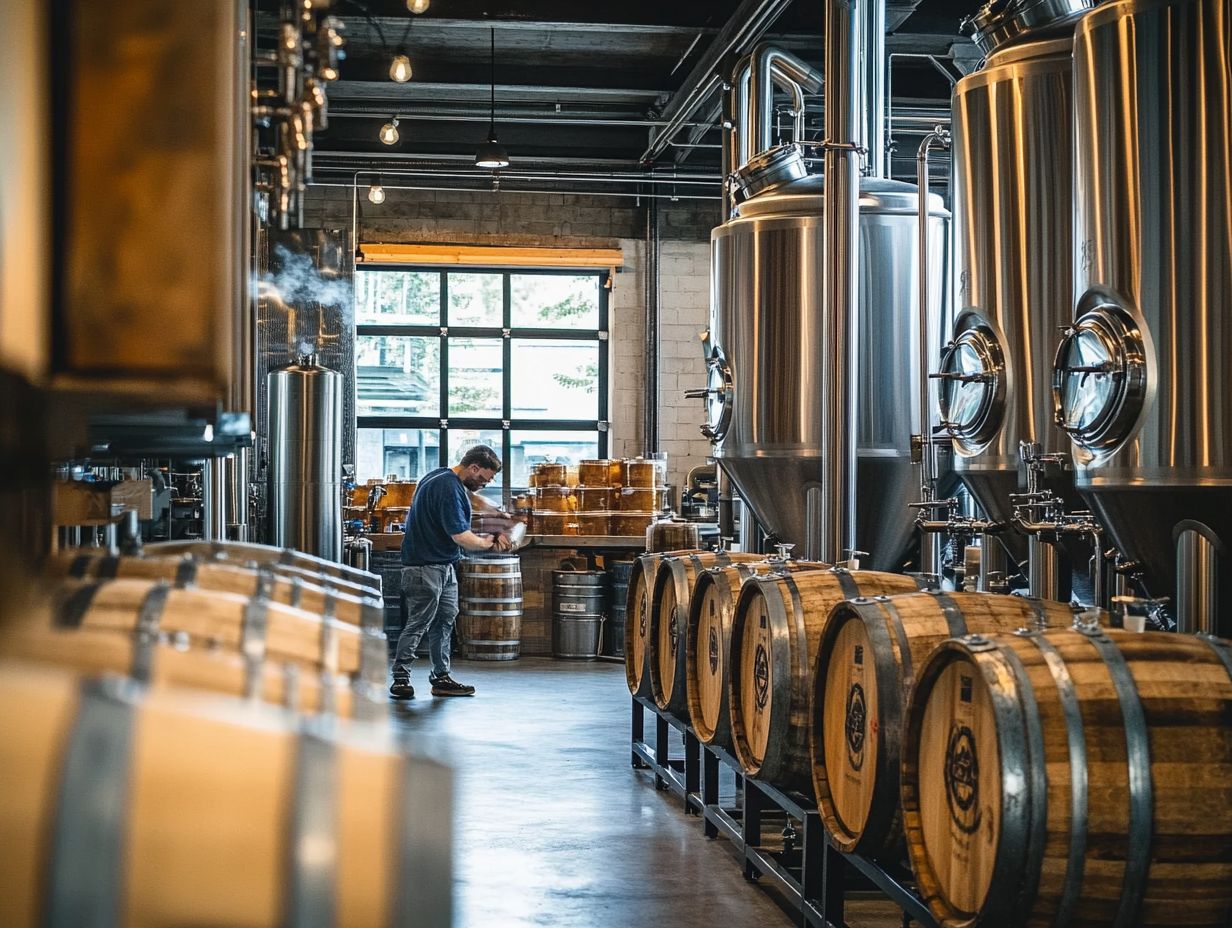
Several factors significantly impact your fermentation process, including temperature, oxygen levels, and the choice of yeast strains. Exercising proper quality control is essential to creating optimal fermentation conditions, which directly influences the final quality of your beer.
Understanding these elements allows you to fine-tune your brewing operations with confidence. For instance, temperature control is key. Higher temperatures can boost yeast activity but may also introduce off-flavors. In contrast, cooler temperatures tend to produce cleaner profiles.
You must also manage oxygen levels with precision. While some oxygen is vital for yeast growth in the initial stages, excessive oxygen can lead to unwanted oxidation and spoilage.
The yeast strain you select dramatically transforms not only the flavor and aroma of your beer but also its fermentation rate. This underscores the importance of choosing the right strain to align perfectly with your desired beer style.
What Are the Benefits of Fermentation in Craft Brewing?
Fermentation in craft brewing presents you with a wealth of advantages, such as the creation of intricate flavors and aromas that elevate your beer experience. It not only enhances the preservation of your brew but also brings potential health benefits linked to consuming fermented products.
This fascinating process encourages creativity among craft brewers, paving the way for unique and innovative beer styles that tantalize the palate.
How Does Fermentation Affect the Flavor and Aroma of Beer?
Fermentation plays a pivotal role in shaping the flavor and aroma of beer. Different yeast strains and fermentation conditions contribute their unique sensory traits, creating a remarkable variety of flavor profiles that discerning beer enthusiasts cherish.
Consider the choice of yeast strain alone; it has the power to unlock a broad spectrum of flavors, ranging from fruity esters to spicy phenols, essential in defining a beer’s unique identity. The fermentation temperature is another crucial factor. Cooler temperatures often yield cleaner profiles, while warmer conditions encourage more complex and pronounced aromas. Keep a close eye on oxygen levels during fermentation to ensure the best quality beer!
Various fermentation techniques, including wild and spontaneous fermentation, introduce unique, often unpredictable flavors that can elevate your sensory experience. All these elements combine to underscore the artistry of brewing, as each decision made during fermentation unveils new dimensions in the overall character of the beverage.
What are the Health Benefits of Fermented Beer?
Fermented beer may present you with several health benefits, particularly when it comes to enhancing digestion. This is thanks to the presence of beneficial microorganisms and improved nutrient availability. These aspects contribute to the perception of fermented beer as a more health-conscious choice compared to its non-fermented counterparts.
The probiotics found in fermented beer, such as lactobacillus and saccharomyces, can improve your gut health by fostering a balanced intestinal microbiome. This balance is essential for effective digestion and nutrient absorption. This variety of beer is also rich in vitamins and minerals, including B vitamins, selenium, and potassium. All of these can enhance your overall well-being. Some studies even suggest that moderate consumption of fermented beer may support cardiovascular health by improving circulation and lowering blood pressure.
The presence of nutrients like protein and minerals in fermented beer contributes to its health benefits. Therefore, if you re looking for healthier alternatives, consider integrating fermented beer into your diet. You’ll love the rich flavors while enjoying its health benefits!
How Can You Start Brewing Your Own Craft Beer at Home?
Embarking on the journey of brewing your own craft beer at home can be an exhilarating experience. It offers you the chance to delve into the fascinating world of brewing science while crafting distinctive flavors to savor.
With the right equipment and a fundamental grasp of the fermentation process, including pre-fermentation and yeast pitching stages, you can easily dive into this rewarding hobby. Unlock a world of creativity and enjoyment!
What Equipment Do You Need?
To start your craft beer brewing journey at home, you’ll need specific equipment that s essential for maintaining quality control throughout the brewing process. Think fermentation vessels, brewing tools, and storage containers all vital for creating that perfect brew in a clean environment.
Key items like airlocks and hydrometers are your best friends for keeping an eye on fermentation. An airlock lets carbon dioxide escape while keeping unwanted contaminants at bay, ensuring your brew’s purity. A hydrometer measures the specific gravity of your concoction, allowing you to track fermentation progress and hit that desired alcohol content just right.
Additionally, Louis Pasteur’s contributions to microbiology emphasized the importance of hygiene and microbial control in brewing. Don’t underestimate the significance of regularly cleaning and sanitizing all your equipment, from kettles to bottles. This step is crucial for avoiding any off-flavors and preserving the integrity of your beer.
By investing your time and resources into these tools, you’ll not only enhance your brewing experience but also elevate the final product to a level that will impress even the most discerning palates.
Ready to brew? Gather your equipment and start experimenting with flavors!
What Are the Steps to Brewing Your Own Beer?
Brewing your own beer involves several key steps, including creating the wort and pitching the yeast. Every step is essential in crafting a delicious brew that you ll be proud to share! This traditional process has been refined over centuries, blending brewing techniques with modern brewing science.
As a brew enthusiast, you ll find that understanding these phases not only demystifies the process but also deepens your appreciation for the art of brewing. Your journey begins with selecting high-quality ingredients malt, hops, and water to create the wort, which is simply the mixture of water and ingredients that will become beer. Barley is commonly used as the primary grain due to its protein and nutrient content.
Once you ve boiled and cooled the wort, it s time to pitch the yeast. This critical moment sparks fermentation, transforming sugars into alcohol and carbon dioxide. You ll need to pay careful attention to temperature and timing to achieve optimal results. Monitoring fermentation parameters such as oxygen levels and nitrogen content is also essential for yeast health and growth.
The conditioning phase allows your beer to mature, developing its flavors while ensuring clarity and carbonation. During the conditioning phase, your beer matures further, completing its transformation. In the end, you ll have a product that reflects your efforts and passion, truly embodying the art of brewing. Maintaining a clean environment and good hygiene during this stage is crucial to prevent microbial contamination.
Frequently Asked Questions
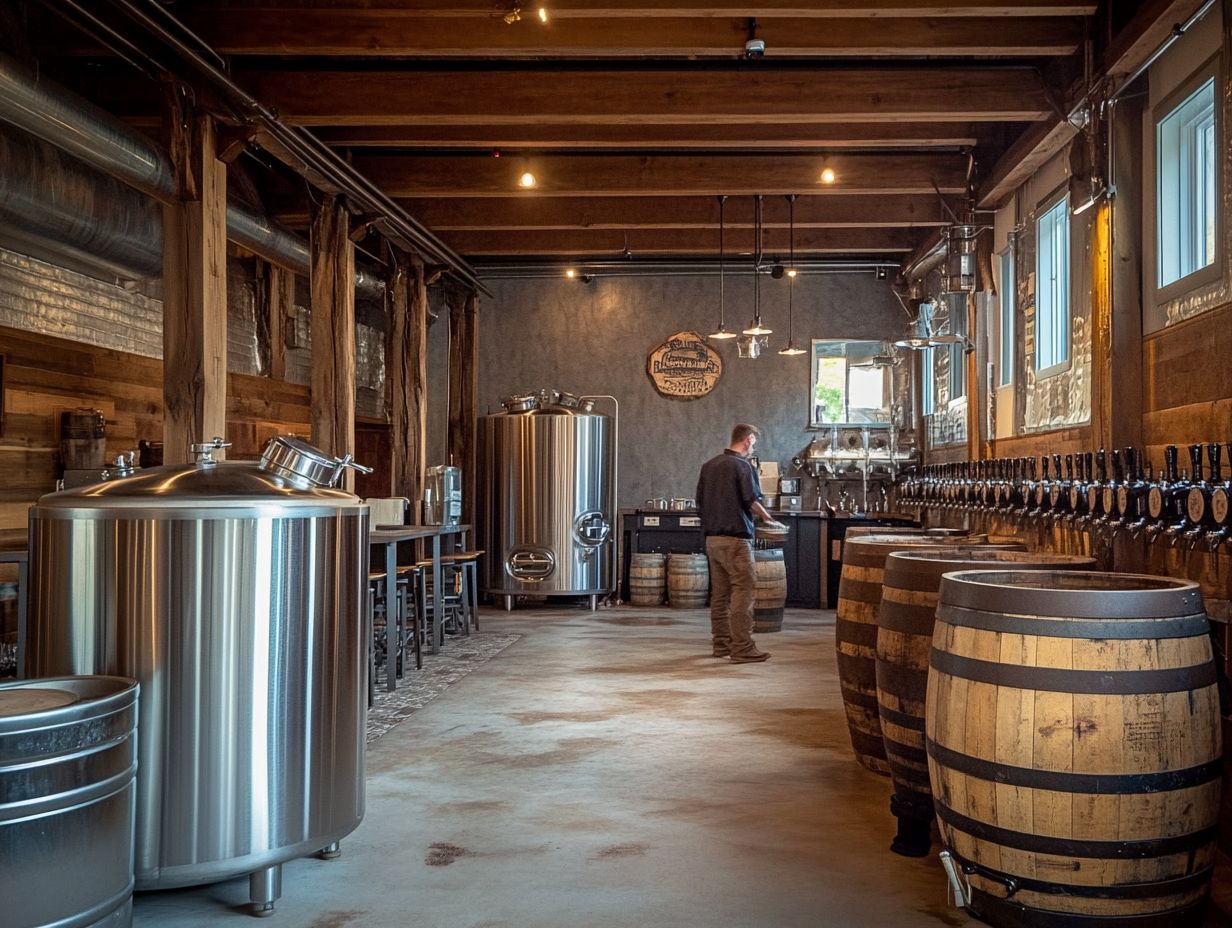
What is fermentation in the context of craft brewing?
Fermentation is the process by which yeast converts sugars into alcohol and carbon dioxide, resulting in the creation of beer in craft brewing. This process is driven by microorganisms such as Saccharomyces cerevisiae, a strain of yeast commonly used by craft brewers.
How important is temperature control during fermentation?
Temperature control is crucial in fermentation as it affects the flavor, aroma, and overall quality of the beer. Different yeast strains have specific temperature ranges for optimal fermentation. Fermentation temperature can influence the production of desirable flavors and aromas in various beer styles.
What is the role of yeast in fermentation?
Yeast is responsible for converting the fermentable sugars in the wort into alcohol and carbon dioxide, resulting in the creation of beer. Different yeast strains can also impart unique flavors and aromas to the final product. Understanding the fermentation characteristics of yeast helps in achieving desired results in craft brewing.
What is the difference between top-fermenting and bottom-fermenting yeast?
Top-fermenting yeast, also known as ale yeast, ferments at warmer temperatures and creates ales with fruity and complex flavors. Bottom-fermenting yeast, or lager yeast, ferments at cooler temperatures and produces clean and crisp lagers. Yeast pitching and the management of fermentation vessels are critical steps in both types of fermentation.
How long does fermentation typically last in craft brewing?
The length of fermentation can vary depending on the type of beer and yeast strain used. On average, it can take anywhere from 1-2 weeks for ales and 3-4 weeks for lagers to complete fermentation. Secondary fermentation or conditioning can further enhance the flavors and carbonation.
Can the flavor of a beer be affected by the fermentation process?
Absolutely! Yeast plays a significant role in the flavor profile of beer, and different fermentation techniques and temperatures can also impact the final taste. That’s why it’s essential for brewers to carefully manage the fermentation process to achieve the desired flavor in their craft brews. The historical contributions of scientists like Louis Pasteur and Emil Hansen have also influenced modern fermentation techniques.
Ready to dive into homebrewing? Grab your ingredients and start your brewing adventure today!


